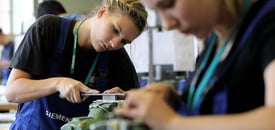“Any good leader, a learning leader, is a systems thinker,” according to Melissa Daimler.
The change and development frequently fundamental for business achievement implies a continuous obligation to getting the hang of, as indicated by Melissa Daimler, head learning official at Udemy.
As a matter of fact, learning “is a continuous act of building abilities, encounters, and information through our work, not around or on top of it,” Daimler wrote in her book “ReCulturing: Design Your Company Culture to Connect with Strategy and Purpose for Lasting Success,” delivered today.
Pandemic, a forcing function for learning
At Udemy, a web based learning and showing commercial center, the most recent couple of years have brought an expanded interest for internet learning.
Daimler told HR Dive the pandemic is a “compelling capacity,” enhancing the significance of work environment culture, learning and improvement, which “we need to continuously be exploring.” Now, with 1,400 representatives, and 185,000 courses drove by 65K educators for a great many students, Udemy “is truly at a pleasant enunciation point,” she expressed, and during the time spent further systematizing its qualities.
Managing learning at a learning company
Daimler’s charge at the organization is proportional its social underpinning of “continuously learning.” She said learning is conveyed through various structures and settings, and is caught and demonstrated through various ranges of abilities.
“An organization isn’t naturally a learning association when it offers preparing programs,” Daimler wrote in her book. “It might try and be the inverse.” So, how does a learning organization oversee learning? To begin with, by trial and error, then by cycle, she expressed — by taking a gander at the greater framework and how it fits together. With profound involvement with the crossing points of culture and learning, and hierarchical and ability improvement, Daimler said this has been the subject of her profession. “What’s more, I feel that any great chief, a learning chief, is a frameworks mastermind [who looks] at how technique interfaces with reason and culture.” But knowing where the organization is inside prepared for abilities improvement, and where “to get abilities from an external perspective,” she said, is her work, as well.
As a CLO at a learning organization, Daimler said she has impact in the organization’s items and arrangements. “I work straightforwardly with our clients, and our client assistance group to ensure we are paying attention to our clients about what’s working.” She said anything Udemy imparts to its clients, the organization is doing too, and in some cases “[w]e get thoughts from clients, and execute them inside.”
At Udemy, she said, “[w]e dive into it — developing authority abilities to stay up with what’s generally anticipated of a public organization.” Udemy, settled in San Francisco, opened up to the world in October. Daimler joined the organization in September after right around 11 years at Adobe, where she said she cut her teeth on everything HR.
“And afterward Twitter came thumping, and that was only an open door to not turn down.” During her four years there, she made sense of, she had the option to conceptualize and fabricate authority, the board and ability improvement, and commitment capacities without any preparation, for the organization’s then-800 representatives.
New means and models for learning
Learning was never about preparing for Daimler, who’s accomplished this labor for a very long time. She said preparing added up to “a shut occasion,” yet learning or hierarchical improvement she’d apparent in a lot more extensive manner.
More successful critical thinking, she said, happens at a foundational level; and in light of the fact that an association is a framework, and working environment learning is attached to hierarchical turn of events, she empowers seeing work — whether projects, techniques, acquisitions or drives — as a potential chance to be utilized for both individual learning and authoritative turn of events.
In any case, how does a business has any idea that somebody has fostered a range of abilities? How can it quantify learning? Contrasted with customary working environment preparing models frequently founded on “utilization of content,” Daimler said organizations could see better achievement while the learning climate is a blend of ages, capacities and present day trial and error pertinent on a fundamental level. She said she trusts there’s an open door, particularly with regards to a work environment companion, to gain from one another, and proposed this could really be more rich ground for learning, and a superior method for estimating.
Frequently, associations aren’t clear about the thing they’re expecting, she said. However, organizations can find that additional way to introduce more clear pictures: “On the off chance that ‘Face imaginative challenges’ is an ideal way of behaving, the association needs to characterize what a ‘innovative gamble’ is and afterward assist representatives with distinguishing ways of mastering and practice abilities to face innovative challenges so they can be perceived, give criticism around that way of behaving and, surprisingly, advanced,” she wrote in her book. Strong growth opportunities, Daimler communicated, tie work environment culture.
– Carla Bell @




